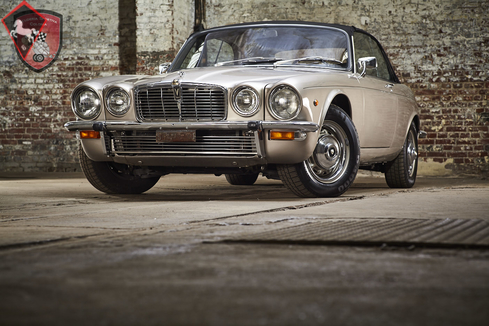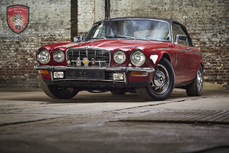Jaguar XJ-C 1975
General description :
* das einzige linksgelenkte 12 Zylinder Jaguar XJ-C Cabriolet der Welt* Ausstellungsfahrzeug bei der internationalen Auto Show in Turin/Italien* Erstauslieferung in Italien nur 2 prominente Vorbesitzer* nur knapp 30.500 Kilometer History: Das Jaguar XJC 5.3 Cabriolet wurde ursprünglich am 29.8.74 unter der Chassis-Nr. 2G 50010 BW als Coupé bei Jaguar produziert. Ausgeliefert wurde dieser Jaguar dann direkt an AVON-STEVENS in Warwick, einer der renommiertesten Karosserie Firmen in England. AVON-STEVENS wurde konsultiert wenn es um besondere Jaguar Konstruktionen ging, sowohl für spezielle Aufbauten, als auch für den Rennsport.. Ziel war es in der gemeinsamen Kooperation mit dem Jaguar Werk, ein wettbewerbsfähiges Cabrio herzustellen um die Reaktion der noblen Kunden zu testen, denn seit 1972 verkaufte Rolls Royce mit großem Erfolg die Corniche. Jaguar versprach sich mit dieser Cabriolet Entwicklung auch einen Teil vom 4 sitzigen Cabriolet Kuchen abzubekommen. Für die Auto Show „Salone dell'automobile di Torino“ 1976 sollte das linksgelenkte 12 Zylinder Prestige Cabriolet fertig sein. Sir William Lyons (Gründer der Fa. Jaguar)- war sehr angetan von der Entwicklung, dem Design und der Raffinesse dieses E-Type Cabriolet Nachfolgers, hier ein Archiv Photo vor der Messe in Turin, provisorisch angemeldet „YDU926S“ Die Präsentation gelang, direkt auf der Turiner Messe wurde dieses „Prototyp“ Cabriolet in Italien verkauft und löste trotz des verhältnismäßig hohen Verkaufspreises, weitere Bestellungen in England, Schottland, Australien und Hongkong aus, so daß noch weitere 11 rechtsgelenkte 12 Zylinder Cabriolets bei AVON STEVENS entstanden. Sogar ein eigener Prospekt entstand von diesem formvollendeten Cabriolet Chassis Nr. 2G 50010 BW blieb das einzig jemals gebaute linksgelenkte 12 Zylinder Cabriolet und wurde in Rom unter der Nummer Roma 50777D zugelassen. In den 90er Jahren gelang dieses einzigartige Cabriolet zu seinem 2ten Besitzer einen berühmten Künstler in Italien. Sorgfältige Pflege und Instandhaltung wurden über all die Jahre in diesen XJ Cabriolet investiert. 2018 konnte dieser Jaguar nach langwierigen Verhandlungen von der Scuderia Sportiva Colonia erworben werden. Ein aktuelles Wertgutachten bescheinigt diesem Einzelstück einen Marktwert von € 460.000.Dieses Angebot ist freibleibend und der Zwischenverkauf vorbehalten. Zusatzleistungen wie große 154 Pt. umfassende Inspektion, neuer TÜV, H-Zulassung, Transport, Anmeldung in Deutschland, Wertgutachten etc. sind gegen separate Aufwandsentschädigung möglich.Dieses hier angebotene Fahrzeug steht in unserer Manufaktur in Köln-Kalk, Vietor Str. 85, 51103 Köln. Hier finden Sie -NUR NACH VORANMELDUNG- eine Auswahl von ständig 80 historisch wertvollen Klassikern.Über unser unser Serviceangebot und Auswahl von Fahrzeugen informieren Sie sich bitte unter http://www.scuderia-sportiva-colonia.com
Karosserieform : Cabriolet
Zylinder : 12
Hubraum : 5343 ccm
Leistung : 268 PS
Höchstgeschwindigkeit : 205 km/h
0-100 km/h : 10 sec
Leergewicht : 1650 kg
Getriebe : Automatik
Gänge : 3
Antrieb : Heck
Bremse Front : Scheibe
Bremse Heck : Scheibe
Tachostand (abgelesen) : n/a
Erstzulassung : n/a
Anzahl Vorbesitzer : 2
Matching numbers : Ja
SSC-Nummer : 403
Außenfarbe : Silber
Innenfarbe : n/a
Herstellerfarbbezeichnung (außen) : n/a
Innenmaterial : Leder
Schiebedach : Nein
Elektrische Fensterheber : Ja
Faltdach : Nein
Klimaanlage : Nein
Servolenkung : Ja
Mwst. ausweisbar : Nein
1975 Jaguar XJ-C is listed for sale on ClassicDigest in Köln by Scuderia Sportiva Colonia for Not priced.
Car Facts
Car type : Car Make : Jaguar Model : XJ-C Engine size : 5.3 Model Year : 1975 Sub type : Convertible Location : Vietor Str. 85 51103 Köln, Germany Vehicle Registration : Undefined
Not priced
Seller Information
Scuderia Sportiva Colonia
Scuderia Sportiva Colonia
+49 (0)221 9853103
Scuderia Sportiva Colonia
+49 (0)221 9853103
People who viewed this Jaguar XJ-C also viewed similar Jaguar listed at ClassicDigest
Other cars listed for sale by this dealer
About Jaguar
Ah, the story of Jaguar, from its early days as the SS Cars Ltd. to its pinnacle with the D-type, and the street-going evolution in the form of the iconic E-type. There's something quintessentially British about this tale, and I'll narrate it as a British journalist might.In the Beginnings:
Our journey into the world of Jaguar begins in the 1930s, when a company known as SS Cars Ltd. emerged. Despite the unfortunate coincidence of their initials with the rising political tensions in Europe, they started producing stylish and performance-oriented cars. The SS 100, introduced in 1936, was a symbol of elegance and speed, setting the stage for what would become Jaguar.
The Birth of Jaguar:
As the shadows of World War II loomed, SS Cars Ltd. wisely decided to disassociate themselves from the SS initials. Thus, in 1945, they officially became Jaguar Cars Ltd., a name that would soon be synonymous with British luxury and performance.
The XK Series:
Jaguar's post-war era brought us the XK 120, a true sensation in 1948. With its sleek design and a powerful 3.4-liter inline-six engine, it became the world's fastest production car. The XK 120 was the blueprint for what lay ahead – Jaguars that blended style with speed in a uniquely British fashion.
The D-type Dominance:
Then came the D-type, a true racing legend. Introduced in 1954, it won Le Mans three times in the 1950s, showcasing Jaguar's engineering prowess. With its innovative monocoque construction and the iconic fin at the back, the D-type was the apex of Jaguar's motorsport success.
The E-type Emergence:
But the true turning point arrived in 1961 with the introduction of the E-type, often described by Enzo Ferrari as "the most beautiful car ever made." Its long bonnet, curvaceous body, and a 3.8-liter engine delivering exhilarating performance made it an instant classic. The E-type was not just a car; it was a work of art on wheels, and it could hit 150 mph on the road.
Street and Racing Success:
The E-type's beauty was matched by its capability on the track. The lightweight E-types were particularly successful in various racing events, cementing Jaguar's reputation as a force to be reckoned with in motorsport.
The Age of Refinement:
As we delve deeper into the Jaguar story, we find that the 1950s and 1960s were an age of refinement and expansion. Alongside the magnificent D-type and the E-type's iconic emergence, Jaguar introduced models that further solidified its reputation for luxury and performance.
The MK2:
In the late 1950s, Jaguar unveiled the MK2, a sports sedan that combined elegance with power. This sleek four-door saloon was a favorite of bank robbers and law enforcement alike, thanks to its exceptional speed and handling. The MK2 was a symbol of Jaguar's ability to blend sophistication with performance and had a successful racing career as well.
The XJ6:
Fast forward to 1968, and Jaguar launched a car that would define luxury saloons for decades to come – the XJ6. It was a masterpiece of engineering and design, featuring a smooth inline-six engine, independent rear suspension, and a spacious, beautifully appointed interior. The XJ6 was a symbol of British elegance and provided a ride so smooth that it seemed to glide over the road. It became the flagship model for Jaguar and set the standard for luxury saloons, showcasing a level of refinement that left competitors in awe.
The Blend of Classic and Modern:
While the MK2 and XJ6 represented the evolution of Jaguar's saloon cars, they maintained the brand's commitment to performance and luxury. These cars didn't just belong on the racetrack; they were equally at home cruising down the grand boulevards or gliding through the English countryside.
The Challenges of Change:
However, as the 1970s arrived, Jaguar, like many British automakers, faced financial challenges and changes in ownership. The British Leyland era brought both opportunities and struggles, as the brand navigated through various mergers and transitions.
Nevertheless, the legacy of the MK2 and XJ6, along with the D-type and E-type, continues to define Jaguar as a manufacturer that combines timeless elegance with a spirit of performance. These classic models, whether driven on winding roads or parked as collectors' treasures, serve as a testament to Jaguar's enduring presence in the world of automotive excellence.
The Jaguar story, from its early days as SS Cars Ltd. to the creation of automotive icons like the E-type, MK2, and XJ6, is a journey that reflects the very essence of British motoring – a blend of luxury, power, and style that continues to captivate enthusiasts and connoisseurs alike.














